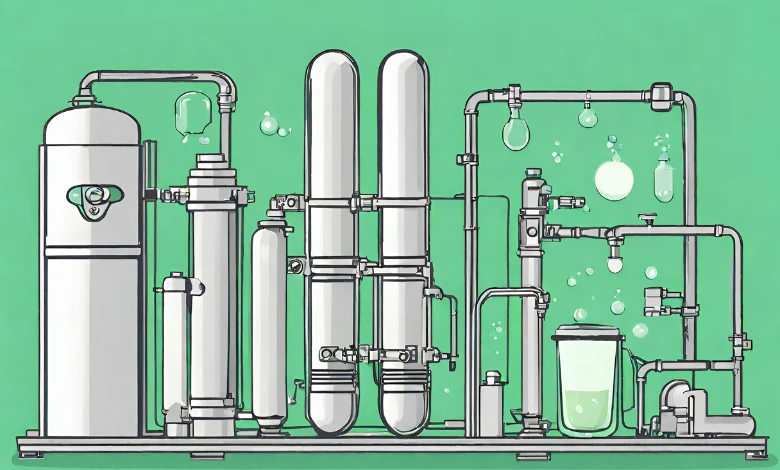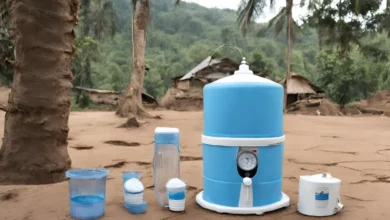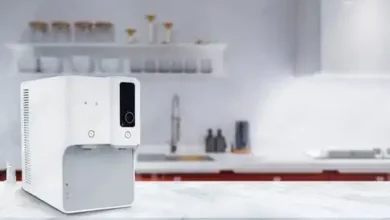Types of Water Purification Technologies Explained:

Choosing the ideal water purifier filter involves assessing your water quality, identifying contaminants, and understanding your purification priorities. Factors such as budget, maintenance, and the specific characteristics of your water source further guide the selection process. By considering these aspects, you can make an informed decision to ensure the effectiveness and efficiency of your chosen water purification system.
Choosing the Optimal Water Purifier: A Comprehensive Guide.
1. Reverse Osmosis (RO):
Technology Description:
Reverse Osmosis (RO) is a water purification process that employs a semi-permeable membrane to remove a wide range of contaminants, including dissolved salts, heavy metals, and microorganisms. Water is forced through the membrane, leaving impurities behind.
Suitability:
RO is ideal for areas with high TDS levels, hard water, and multiple contaminants. It provides comprehensive purification and is suitable for households where water quality is a significant concern.
TDS Level:
RO is well-suited for high TDS water, typically exceeding 500 ppm. It effectively addresses issues related to mineral content and hardness.
Cost:
While RO systems have a moderate initial cost, they may require periodic maintenance and replacement of membranes, which can contribute to ongoing expenses. The long-term benefits in water quality often justify the initial investment.
2. Activated Carbon Filtration:
Technology Description:
Activated Carbon Filtration involves passing water through activated carbon, which adsorbs impurities, chlorine, volatile organic compounds (VOCs), and improves taste and odor. It provides a chemical filtration method.
Suitability:
This technology is suitable for areas with moderate TDS levels and where the primary concern is improving the taste and odor of water. It is a practical choice for those seeking better-tasting water without complex purification needs.
TDS Level:
Activated carbon filtration works well for TDS levels below 500 ppm. It is effective in addressing issues related to organic compounds and taste improvement.
Cost:
Activated carbon filtration is generally budget-friendly, with the periodic replacement of carbon filters being the primary ongoing cost.
3. UV (Ultraviolet) Purification:
Technology Description:
UV Purification employs ultraviolet light to inactivate microorganisms by disrupting their DNA, preventing them from reproducing. It is a non-chemical method effective against bacteria and viruses.
Suitability:
UV purification is ideal for areas with microbiological contamination concerns. It is a valuable addition to water treatment systems, especially for those relying on well water or from sources prone to microbial contamination.
TDS Level:
UV purification is effective for various TDS levels, with its primary focus on microbial disinfection. It doesn’t significantly impact mineral content.
Cost:
UV purification has a moderate initial cost and low operating costs. However, it requires electricity to operate.
4. Ultrafiltration (UF):
Technology Description:
Ultrafiltration (UF) uses a membrane with larger pores than RO to remove larger particles and microorganisms. It is a physical filtration method that allows essential minerals to pass through.
Suitability:
UF is suitable for areas with concerns about microbial contamination and larger particles. It is a practical choice for those seeking a balance between effective purification and mineral retention.
TDS Level:
UF is effective for various TDS levels, making it versatile in addressing water quality challenges.
Cost:
UF systems are generally budget-friendly, have low operating costs, and do not require electricity.
5. Gravity-Based Water Purifiers:
Technology Description:
Gravity-Based Water Purifiers operate without electricity, relying on the force of gravity to push water through different filtration stages, including sediment and activated carbon filters.
Suitability:
These purifiers are suitable for areas with intermittent power supply and lower TDS levels. They provide basic filtration and are often chosen for their simplicity.
TDS Level:
Gravity-based purifiers are best for lower TDS levels, making them suitable for regions with relatively good water quality.
Cost:
Gravity-based purifiers are budget-friendly, making them accessible to a wide range of users. They are cost-effective in terms of both initial investment and maintenance.
6. Candle Filters:
Technology Description:
Candle Filters, typically made of ceramic, provide physical filtration by trapping impurities and bacteria. They are reusable and washable, making them suitable for areas with limited access to replacement filters.
Suitability:
Candle filters are suitable for areas with microbial contamination concerns and larger particles. Their reusability makes them practical for locations with limited filter replacements.
TDS Level:
Candle filters are effective for various TDS levels, offering flexibility in addressing water quality challenges.
Cost:
While candle filters may have a slightly higher initial cost due to their reusable nature, they are generally budget-friendly in the long run.
7. Multi-Stage Filtration Systems:
Technology Description:
Multi-Stage Filtration Systems incorporate multiple purification technologies in a single unit. These may include pre-filters, activated carbon filters, and post-RO filters for comprehensive water purification.
Suitability:
These systems are versatile and suitable for areas with diverse water quality challenges. They provide a comprehensive solution for households with varying purification needs.
TDS Level:
Multi-stage systems are effective for various TDS levels, offering flexibility to address different water quality issues.
Cost:
The cost of multi-stage filtration systems can vary. While they may have a moderate initial cost, ongoing maintenance costs should be considered. The long-term benefits in water quality justify the investment for many users.
In choosing a water purification technology for home use, it’s essential to consider individual needs, water quality, and budget constraints. Regular maintenance and adherence to manufacturer guidelines are critical to ensure the continued efficiency of the chosen purification system.
How do I know which filter to buy?
- Water Quality Analysis:
- If you’re uncertain about your water quality, consider conducting a comprehensive water test. Many local health departments or water treatment companies offer testing services. You can also check with your municipal water supplier for water quality reports.
- Identify Contaminants:
- Once you have the results of your water test, identify the specific contaminants present. Common contaminants include bacteria, viruses, sediment, chlorine, heavy metals (like lead or arsenic), and various chemicals. Knowing the contaminants will help you choose the most suitable filtration technology.
- Determine Water Purification Needs:
- Consider your priorities in water purification. If microbial contamination is a concern, prioritize filters with disinfection capabilities (UV, RO). For improving taste and removing chemicals, activated carbon filters are effective. If you need a multi-pronged approach, consider systems with multiple stages.
- Understand Filter Technologies:
- Each water purification technology has its strengths and weaknesses. RO is effective against a broad range of contaminants but can be water-wasteful. Activated carbon is excellent for taste and odor improvement. UV is ideal for microbial disinfection. Understanding these technologies will help you make an informed decision.
- Consider Water Source:
- Different water sources may have unique challenges. Well water may contain more sediment and minerals, while municipal water may have added disinfectants like chlorine. Consider the specific characteristics of your water source when choosing a filter.
- Check Flow Rate and Capacity:
- Consider the water demands of your household. High-flow systems may be necessary for larger households, while smaller systems may suffice for singles or couples. Ensure that the chosen filter system can meet your daily water needs without compromising efficiency.
- Budget Considerations:
- Determine your budget for both the initial purchase and ongoing maintenance. RO systems, for example, may have higher upfront costs and more frequent filter replacements. Consider the long-term costs and benefits of each option.
- Ease of Maintenance:
- Evaluate the maintenance requirements of each filter type. Some filters are user-friendly with easy replacement procedures, while others may require professional assistance. Choose a system that aligns with your maintenance capabilities and preferences.
- Energy Requirements:
- Consider the availability of a reliable power supply. RO and UV systems typically require electricity, while gravity-based filters operate without power. Ensure that the chosen technology is compatible with your living conditions.
- Brand and Model Reviews:
- Research reviews for specific water purifier brands and models. Look for feedback on durability, ease of use, and the effectiveness of the filtration process. Customer reviews can provide valuable insights into real-world performance.
- Certifications and Standards:
- Check for certifications from reputable organizations such as NSF, WQA, or ISI. These certifications indicate that the water purifier meets specific quality and safety standards. Look for products with these certifications for added assurance.
- Consult with Experts:
- If you’re unsure about the best choice for your situation, consult with water treatment professionals or experts. They can analyze your water test results, understand your needs, and recommend a system tailored to your specific circumstances.
By carefully considering these factors, you can choose a water purifier that aligns with your water quality, budget, and lifestyle preferences. Keep in mind that water quality can change over time, so periodic reevaluation of your filtration needs is recommended.
What is the difference between a water filter and a purifier?
The distinction between a water filter and a water purifier lies in the scope and depth of their respective water treatment capabilities. Both devices are designed to enhance water quality, but they differ in the range of contaminants they can effectively address.
Water Filter:
1. Mechanism:
- Physical Filtration: Water filters operate primarily through physical filtration mechanisms. They use porous materials or barriers to trap and remove impurities present in the water.
2. Contaminant Removal:
- Particulate Matter: Filters excel at removing larger particles like sediment, sand, and debris, contributing to clearer and visually cleaner water.
- Taste and Odor Improvement: Activated carbon filters, commonly employed in water filtration, adsorb and capture compounds responsible for unpleasant tastes and odors, such as chlorine and organic chemicals.
3. Applications:
- Point-of-Use Devices: Water filters are commonly applied at the point of use, such as in countertop pitchers, faucet attachments, or under-sink systems.
- Aesthetic Enhancement: Filters are suitable for enhancing the aesthetic qualities of water, making it more palatable and enjoyable for consumption.
4. Limitations:
- Microorganisms: Basic water filters may not effectively eliminate microorganisms like bacteria and viruses. They are generally more focused on physical particles and chemical impurities.
Water Purifier:
1. Comprehensive Treatment:
- Microbial Contaminant Removal: Water purifiers are designed to address a broader spectrum of contaminants, including microorganisms like bacteria, viruses, and parasites.
- Chemical and Dissolved Impurity Elimination: Purifiers often utilize advanced technologies such as UV disinfection, reverse osmosis, or chemical treatment to effectively remove or neutralize a wider range of chemical contaminants, dissolved minerals, and harmful microorganisms.
2. Advanced Technologies:
- UV Purification: Water purifiers may incorporate UV light to disinfect water by disrupting the DNA of microorganisms, preventing their ability to reproduce.
- Reverse Osmosis (RO): This technology involves forcing water through a semi-permeable membrane to remove contaminants at a molecular level, ensuring a higher degree of purification.
3. Applications:
- Point-of-Use and Whole-House Systems: Water purifiers are employed in both point-of-use devices and whole-house systems, ensuring that all water entering a home is treated comprehensively.
- Critical for Waterborne Diseases: In areas with a high risk of waterborne diseases, water purifiers play a crucial role in safeguarding public health.
4. Varied Use Cases:
- Portable Purifiers: Compact, portable water purifiers are valuable for travelers and outdoor enthusiasts, providing a reliable source of safe drinking water in diverse environments.
Considerations for Choosing:
1. Water Quality Assessment:
- Contaminant Profile: Assess the specific contaminants present in your water source to determine the appropriate level of treatment needed.
2. Intended Use:
- Drinking Water vs. Household Use: Consider whether you need treatment for drinking water only or for all water used in your household.
3. Maintenance and Cost:
- Filter Replacement vs. System Maintenance: Filters generally require regular replacement, while purifiers may need periodic maintenance or replacement of components like UV bulbs or membranes.
4. Certifications:
- NSF/ANSI Certification: Look for products with certifications indicating their effectiveness in removing specific contaminants to ensure they meet the necessary standards.
In summary, while both water filters and purifiers contribute to improved water quality, the choice between them depends on the specific contaminants in your water source and the level of purification required for your intended use. Whether you opt for a filter or a purifier, understanding their capabilities and certifications is crucial for making an informed decision.
Read here for Best Water Purifier in India

